Status Operational Ridership 2,705,823 (FY13) Distance travelled 350 miles (563 km) First service 1 June 2000 Stops 27 | Average journey time 8 hours 15 minutes | |
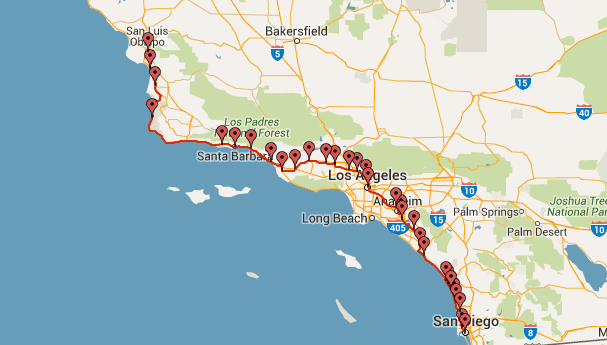 | ||
Current operators | ||
Amtrak s pacific surfliner los angeles to san diego
The Pacific Surfliner is a 350-mile (560 km) passenger train service operated by Amtrak, with funding from the California Department of Transportation as part of the Amtrak California network. The Pacific Surfliner serves the communities on the coast of Southern California between San Diego and San Luis Obispo.
Contents
- Amtrak s pacific surfliner los angeles to san diego
- Operations
- LOSSAN
- Stations served
- Rolling stock
- Track hosts
- References
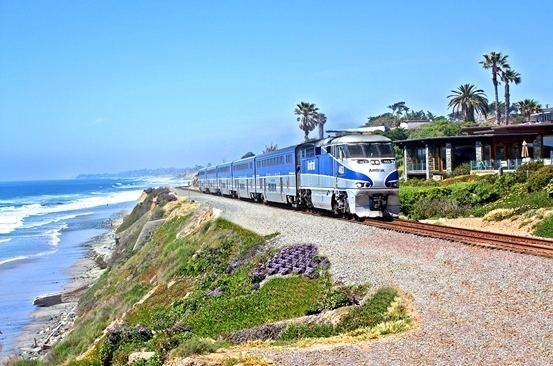
The service carried over 2.7 million passengers during fiscal year 2013, a 2.5% increase from FY2012. Total revenue during FY2013 was $62,576,548, an increase of 6.8% over FY2012. The Pacific Surfliner was Amtrak's third-busiest service (exceeded in ridership only by the Northeast Regional and Acela Express), and the busiest outside the Northeast Corridor.
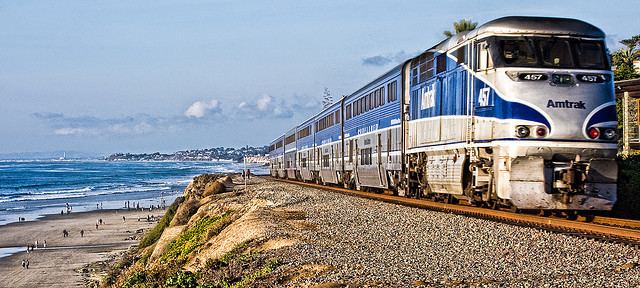
The Los Angeles-San Diego portion of the Pacific Surfliner route was once served by the Santa Fe Railway's San Diegan passenger trains until Amtrak took over operations. Initially there were three daily trips, but in 1976 the schedule was expanded. In 1988 the service was extended to Santa Barbara, followed in 1995 with one trip a day going all the way to San Luis Obispo. As the name "San Diegan" no longer reflected the extent of the route, it was renamed the Pacific Surfliner in 2000. The route is named after the Atchison, Topeka and Santa Fe Railway's Surf Line.
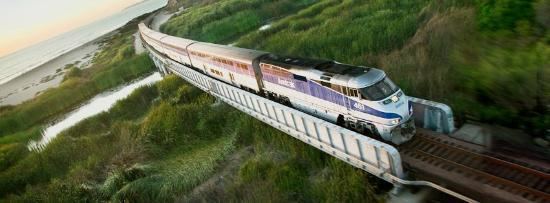
Operations
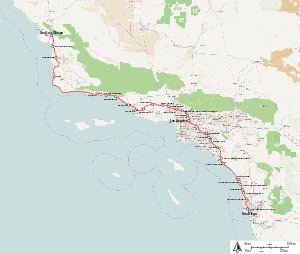
The 350-mile (563 km) San Luis Obispo-San Diego trip takes approximately 8½ hours with an average speed of 41.2 miles per hour (66 km/h); maximum track speed is 79 to 90 miles per hour (127 to 145 km/h). Much of the Pacific Surfliner's scenic route follows the Pacific coast, although trains travel inland through expansive farmlands in Ventura County and industrial backlots in the Los Angeles Basin, San Fernando Valley, and parts of Orange County. The Pacific Surfliner operates 14 daily trains between LA and San Diego daily.
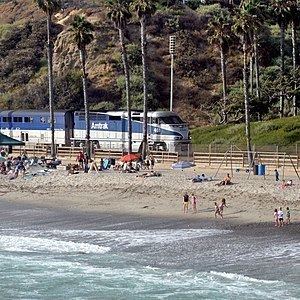
On the northernmost part, there are five trains per day in each direction. Thruway Motorcoach connections are available between Santa Barbara, California and Paso Robles during hours when that part of the Coast Line track is in use by freight trains.
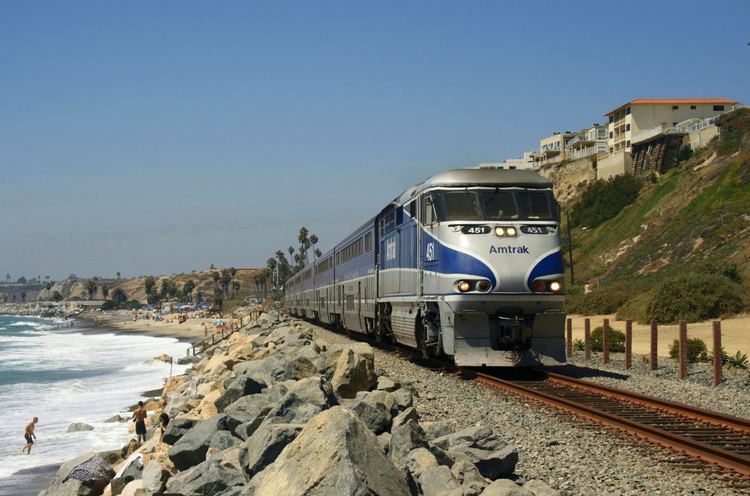
The 500 series trains go from LA to San Diego and the 700 series trains go onto the nothernmost part of the route. For trains 761, 566, 567, and 790, they operate slightly different schedules on weekends and they are recognized by having a 1 in front of their number (i.e. 1761).
Because the San Diego, San Luis Obispo, and Goleta stations are not equipped to turn equipment, trains are operated in push-pull mode. The locomotive is at the rear of the train, pushing the train from Goleta/San Luis Obispo or San Diego to Los Angeles. At Los Angeles, the train reverses at the station, and pulls the train to San Diego or Goleta/San Luis Obispo, respectively. A project is currently being prepared for run-through tracks at Union Station in Los Angeles. As of 2007, the route recovers 63% of its operating expenses through ticket sales.
LOSSAN
Local agencies along with the host railroads formed the Los Angeles–San Diego-San Luis Obispo Rail Corridor Agency (LOSSAN) in 1989. The Pacific Surfliner is operated by Amtrak under the Amtrak California brand with funding provided by the California Department of Transportation (Caltrans). Serious discussions were held in 2009 regarding the local agencies administering the service rather than Caltrans. California Senate Bill No. 1225, passed in 2014, allowed LOSSAN to amend the joint powers agreement and become the sponsor of state-supported intercity passenger rail service in the corridor. In mid-2015, LOSSAN assumed oversight for the Surfliner. They are also working with Caltrans to assess rail operations from Los Angeles to San Diego to develop better connections, close gaps in the schedule, and optimize the assets of the railroad.
Stations served
Rolling stock
The Pacific Surfliner uses a fleet of "Surfliner" bi-level, high-capacity passenger cars owned by Amtrak (AMTK) and the California Department of Transportation (CDTX). Each trainset has a business class car, three coach cars, a coach/café car with food sales on the lower level, and a coach/baggage/cab car equipped with coach seating, a checked baggage space on the lower level, and engineer's operating cab and headlights on one end, allowing the train to be operated in push-pull mode.
The "Surfliner" cars used on the route are painted in a blue and silver livery that is unique to the Pacific Surfliner. "Surfliner" cars are equipped with overhead luggage racks, reclining seats with tray tables and footrests, reading lights, restrooms, AmtrakConnect WiFi, 120v power outlets, and a wheelchair ramp.
High ridership on the Pacific Surfliner led officials to add a third coach to most trainsets. But due to a lack of "Surfliner" coaches, Superliner coaches from Amtrak's long-distance fleet are often used on the route. Because these Superliner coaches lack automatic doors they are usually placed between the cab car and "Surfliner" coach car.
Car shortages have also led Amtrak to operate one single-level trainset on the Pacific Surfliner consisting of a 6 Amfleet I or Horizon coach cars, a Horizon club-dinette car providing business class seating and food sales, and a Non-Powered Control Unit (an old F40PH locomotive converted to serve as a cab/baggage car.)
All Pacific Surfliner trains are pulled by Amtrak-owned locomotives. Amtrak maintains a dedicated fleet of 15 EMD F59PHI locomotives painted to match the livery of the "Surfliner" cars. This fleet is slated to be supplemented and eventually replaced by a new order of 20 Siemens SC-44 Charger locomotives between 2016-2018. Locomotives from the long-distance fleet are often used, including the P42DC. Also the NCPUs 90230 and 90208 with a P42DC will be used occasionally with Amfleet II coaches.
Two new single-level trainsets manufactured by Talgo will enter service under a five-year lease. These are expected to improve service between Los Angeles and San Luis Obispo by 25 minutes while being more efficient than a conventional coach set. The two trains, each of 14 cars, were originally constructed in Milwaukee for the state of Wisconsin as part of a project to enhance the existing "Hiawatha Service" between Chicago and Milwaukee, and extend service west to Madison, the state capital. The sets never entered service due to political controversies and were subsequently moved to Amtrak's central maintenance complex in Beech Grove, Ind. in 2014. The lease also includes three spare cars -- a cab/auxiliary power car, an end coach/baggage car, and a food service car. Two similar sets, each of 13 cars, were built at the same time for the Oregon DOT and are in "Cascades" service between Eugene, Ore., Seattle, Wash. and Vancouver, B.C., Canada.
